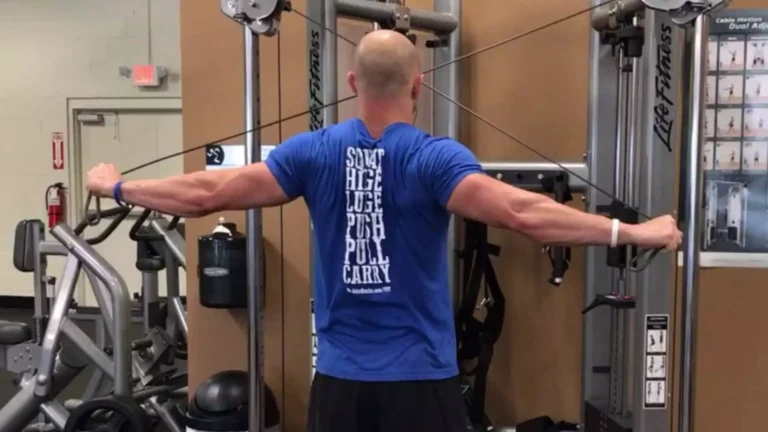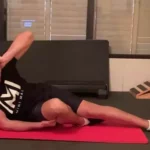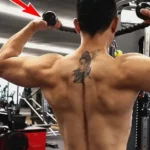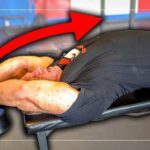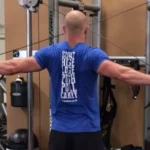Reverse cable crossover is an exercise which is help to tone and strengthen the posterior part of the deltoid muscle. To build a 3D shoulder you have to train each and every head of the deltoid muscle the anterior head, lateral head, and rear head.
In this article, you will know muscle working, benefits, tips, how to perform, and alternative exercises of reverse cable crossover. Stay tuned to this article and read the whole content with details.
You may hear reverse cable crossover by other names such as
- Cable reverse crossover
- Reverse cable pull
- Rear delt cable fly
- Standing cable reverse fly
- Reverse cable fly
Anatomy behind reverse cable crossover
The posterior part of the deltoid muscle is originated from the scapula ( spine of scapula ) and is inserted into the deltoid tuberosity of the humerus(arm bone).
The prime function of the rear deltoid muscle is horizontal abduction and extension of the arm. The deltoid is a shoulder stabilizer during any movements, so you have to train each deltoid muscle correctly.
Reverse Cable Crossover
This is an exercise that targets your rear delt and muscle of the posterior shoulder. To perform this exercise you need a cable Cable pully machine.
Normally you can perform reverse cable cross in a standing position. Engage your core muscle, keep your spine straight, and upper body upright, and perform slowly.
Muscle worked
Prime mover
Posterior part of the deltoid muscle.
Secondary Mover
Supraspinatus, infraspinatus, teres minor, subscapularis, rhomboids, trapezius, and lateral deltoid muscle.
How to perform Reverse Cable Crossover
- Adjust the pully above your head and adjust the weight accordingly(lightweight).
- Stand in the center of the cable crossover machine, facing forwards(towards the machine).
- After standing keep your shoulder wider and bend your knee slightly.
- Cross your hand in front of your shoulder with the right cable in your left hand and the left cable in your right hand.
- Elbows are kept slightly bent and pull your elbow out and back by the rear deltoid.
- Pull both cables symmetrically until your arm and shoulder are on the same line.
- To return to your starting position slowly release both hands until you feel enough stretch on your upper back.
- Repeat the desired number of repetitions.
Keep in mind during performing reverse cable crossover
- The spine will be straight and the torso upright, and do not lean backward or forward.
- Keep your core engaged for a straight spine and perfect form.
- Don,t do jerky movements, perform them slowly with concentration.
- Keep your elbow bent slightly throughout the whole exercise.
- Pull the weight carefully and slowly to prevent muscular injury and shoulder injury.
- Breathe in at starting position and exhale while you perform.
Perform 3 to 4 sets of 12 repetitions to get desired hypertrophy on muscle. Don’t use heavy weights in this exercise, it may injure your shoulder joint.
Pull the weight slowly, at the end range hold for 2 sec , feel the contraction, and repeat.
Reverse cable crossover alternatives
Cable reverse crossover is one of the best exercises to train your rear delt and make it stronger, and bigger. Except reverse cable cross exercise, there are so many exercises that also help to grow your rear deltoid.
Alternative exercises are a good option to hit your muscle fiber in all directions. Even it gives you some variation to perform exercises and make your muscle hypertrophic maximally.
1. Cable High Row
Cable high row is one of the alternatives of the reverse cable pull exercise. Cable high row is a very beneficial way to mix up your shoulder training with some gym equipment.
This will help to hit your rear deltoid muscle and make it stronger and bigger.
Equipment
Cable machine and a dual-handled rope attachment.
Muscle worked
Primary mover: Rear delt and lateral deltoid muscle.
Secondary mover: Trapezius and Rhomboids

How to do cable high row
- Stand with your wider feet and face toward the cable machine.
- Attach the cable attachment about your chest height and attach the rope handle with it.
- Take some steps back until the cable is pulled taut.
- Relax your shoulder muscle until you feel a gentle stretch on your upper back.
- Pull the ropes toward you, your both elbows and shoulder should be on the same line.
- Slowly and carefully extend your elbow back from the starting position.
- Repeat for the desired repetitions.
Keep the weight light enough, and perform 2-3 sets of 12 repetitions.
Keep in mind during cable high row
- During this exercise, when pulling the rope your elbow should bend 45-90 degrees away from your side.
- Keep your core muscle engaged during exercises.
- Posture should be correct, spine erect, upper body upright, and keep your torso tall.
- Do this exercise slowly and very carefully, then the result will be better.
2. Single arm bent over row
Single arm bent over row is another best exercise to build your rear delt. In your shoulder workout routine, you can easily add this exercise.
This is a multi-joint movement exercise that will help you to gain strength in your posterior deltoid. This is the best alternative of reverse cable crossover.
Equipment
A dumble and a gym bench
Muscle Worked
Prime mover: Rear deltoid
Secondary mover: Back muscle, biceps, and transverse abdominals.

How to do it
- For the right side deltoid muscle, places your left knee and left hand on the bench, and keep your elbow straight.
- Keep your right foot on the floor and extend your right leg slightly behind you.
- Keep engaging your core muscle, flat your back and spine should be neutral.
- Hold a medium-weight dumbbell in your right hand, with your arm reaching down.
- Bent your elbow, pulling it up and back until your arm is in line with your lower chest.
- At the end of the range squeeze your shoulder blades together.
- Lower the weight very carefully and repeat for the desired repetition.
Take weight accordingly and perform 3 to 4 sets of 12 to 15 repetitions.
Keep in mind during single arm bent over row
- Keep your core muscle engaged, your spine should be straight and your upper back stable enough.
- Keep your head looking forward and the left hand and shoulder girdle should be contracted, and stable.
- Don,t use heavyweight, use medium weight accordingly.
Read More: How to perform rear delt rope pull perfectly
3. Standing bent over lateral raise
Standing bent over lateral raise is another alternative of reverse cable crossover. It is a long arm lateral movement, so start with a lighter weight. As you get stronger you can work up to a heavier weight.
If you start with a heavy weight it can set you up for injury. In this variation, a lighter weight can provide a safe way to build strength.
Equipment
Pair of light to medium-weighted dumbbells.
Muscle worked
Primary mover: Posterior deltoid, middle deltoid
Secondary mover: Anterior deltoid, rhomboids, middle trapezius.

How to do it
- Hold a pair of dumble tightly, Keeping your palms facing each other.
- Stand with your feet together, slightly bent your knee, and stabilize your legs.
- Bend forward at the hips(approx 140 degrees), keeping your back straight.
- Raise your arms up and out, as you spread your arms until both arms are parallel to the floor.
- At the top of the movement squeeze your both shoulder blade.
- Lower the dumbbells back to the starting position carefully and slowly.
- The dumbells you are using should be light enough.
- You can do 2 to 3 sets of 10 to 12 repetitions.
Keep in mind during standing bent over lateral raise
- Keep your core engaged while you doing this exercise.
- Stabilize your shoulder girdle, before you start this exercise.
- Keep your head in line with your body during bent-over lateral raises.
4. Side-lying external rotation
Side-lying external rotation is an exercise that is mainly focused on the posterior deltoid by external rotation movements. This also targets the rotator cuff muscle along with the rear deltoid.
Equipment
One towel and a lightweight dumble.
Muscles worked
Prime mover: Posterior deltoid, Rotator cuff
secondary mover: Middle head of trapezius, rhomboids

How to do it
- Use a mat and lie on one side, holding a lightweight dumbbell.
- Keep your upper arm on your side with a 90-degree bend elbow.
- Rotate your arm on your torso as far as you can without letting your uppermost arm drift off your body.
- Hold it for 1-2 sec, carefully, and slowly lower it back to the starting position.
- Do 2 to 3 sets of 12 repetitions.
Keep in mind during side-lying external rotation
- During exercise keep your uppermost arm resting on your body and allow it to rotate like a door hinge.
- Keep your core and back engaged during this exercise.
- Don’t move your upper body, move your shoulder joint through the full range of motion.
- Start from lightweight to prevent shoulder injury.
Some Best Shoulder Workout Routine Exercises
Here are some shoulder workout routine exercises, which can be most beneficial to make your shoulder bulky and strong. Perform this exercise slowly and hold at the end range of motion to fell maximum hypertrophy into muscle fiber.
Dumbbell Shoulder Workout
| Exercises | Sets and Reps |
|---|---|
| Reverse flye | Sets 3 Reps 10 |
| Lateral raise | Sets 3 Reps 10 |
| Arnold press | Sets 3 Reps 10 |
Home Shoulder Workout
| Exercises | Sets and Reps |
|---|---|
| 30/30 push press | Sets 3 Time 2min |
| Lateral raise | Sets 3 Reps 12 |
| Front raise | Sets 3 Reps 12 |
| Reverse flye | Sets 3 Reps 12 |
Supersets Shoulder Workout
| Exercises | Sets ans Reps |
|---|---|
| Push press | Sets 4 Reps 10 |
| Upright row | Sets 4 Reps 10 |
| Seated dumbbell overhead press | Sets 4 Reps 12 |
| Prone reverse dumbbell flye | Sets 4 Reps 12 |
| Standing dumbbell lateral raise | Sets 4 Reps 15 |
| Cable face pull | Sets 4 Reps 15 |
Gym Rings Shoulder Workout
| Exercises | Sets and Reps |
|---|---|
| Front support | Sets 5 Reps 6 |
| Pull-up | Sets 5 Reps 3 |
| L-sit | Sets 5 Time 10 sec |
| Dip | Sets 5 Reps 5 |
| Inverted row | Sets 3 Reps 8 |
| Press-up | Sets 3 Reps 8 |
Bottom line
The rear or posterior deltoids are as important as the anterior and middle delt, to build a 3D shoulder. Deltoids are important shoulder stabilizers and they are mostly used in many pulling movements.
Through these exercises, you can build your rear delt and strengthen it. As with any exercise routine, it’s a better idea to check with a qualified trainer before trying these exercises for the first time.
That’s it! Next time when someone wonders, “How to perform reverse cable crossover?” Take charge and start explaining. Have question? Don’t hesitate to let me know in the comment section below. I will try my best to answer all of them.
Frequently asked question
How do reverse cable crossovers work?
To perform reverse cable crossover you have to stand in front of the pully machine facing forward. In this exercise, you are targeting on rear delt and rotator cuff muscle which contribute to building a bigger and stronger shoulder.
What is a reverse crossover?
Reverse crossover is an exercise that is performed on a cable pulley machine to train your posterior deltoid muscle. It is also so beneficial exercise for upper back exercise.
Is reverse cable fly well?
During reverse cable flying, if your posture and form will perfect it will not hurt you. During this exercise keep your core engage and before performing you have to do some mobilization exercises of the shoulder joint.
reverse cable crossover muscles worked?
in cable reverse crossover you are mainly hitting on your posterior deltoid muscle, which is the prime mover. bur secondarily you are targeted on supraspinatus, infraspinatus, teres minor subscapularis, rhomboids, and shoulder surrounding muscle.
Which are reverse cable crossover alternatives?
The name of reverse cable pull alternatives are
Dumbbell Chest Press.
Standing One-Arm Landmine Press.
Dumbbell Pullover.
Dumbbell Chest Fly.
Push-ups Plus.
Resistance Band Crossover.
Resistance Band Low Crossover.
Reverse cable crossover benefits?
There are certain benefits of cable reverse crossover there are
Stabilize your shoulder.
build your posterior deltoid.
Promote 3D shoulder.
Prevent shoulder injury.
What can I use instead of a reverse cable fly?
Instead of a reverse cable fly, you can perform these exercises accordingly
Standing One-Arm Landmine Press.
Dumbbell Pullover.
Resistance Band Crossover.
Resistance Band Low Crossover.
Are cable crossovers enough for the chest?
Cable crossover is mainly targeted for the posterior deltoid and cuff muscle to build your shoulder bigger and stronger. Cable crossover is not the best exercise for the chest its best for the shoulder.
References
- https://www.ncbi.nlm.nih.gov/pmc/articles/PMC7745915/
- https://teachmeanatomy.info/back/muscles/superficial/
- https://workoutlabs.com/exercise-guide/reverse-cable-flyesreverse-cable-crossovers/
- https://www.muscleandstrength.com/exercises/standing-cable-flys.html
